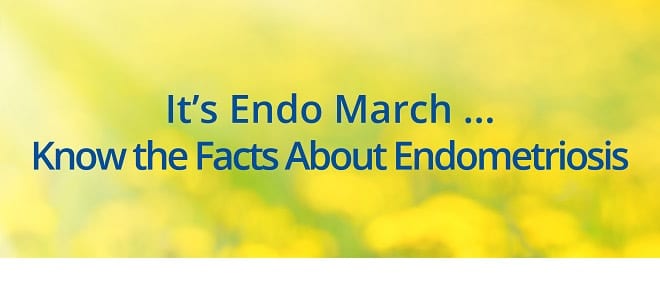

By Dr Anne Poliness, City Fertility Centre Melbourne.
Endometriosis is a condition that affects 10 per cent of women in their reproductive years. It results when endometrial cells (womb lining) grow in the wrong place outside the uterus or womb. These cells can alter the environment of the pelvis and reproductive tract, causing a range of issues including pain, heavy periods and fertility problems.
This month is Endo March, which is a worldwide campaign aimed at raising awareness of endometriosis and the symptoms, causes, impacts and treatment options available. So below is my endometriosis summary, which I hope will help raise awareness and assist women to manage their condition well.
The earlier the diagnosis of endometriosis is made, the better informed a woman is about treatment choices and the sooner she can be helped.
A female’s uterus is lined with the endometrial cells, which are shed monthly if pregnancy does not occur. The endometrial tissue mainly passes through the cervix and vagina in the form of menstrual bleeding. Some endometrial tissue also goes through the tubes and lands in the pelvis, but usually it is absorbed by normal body channels. In some women, for reasons that are presently unknown, the endometrial tissue that lands in the pelvis persists and grows. This is endometriosis.
It is likely that there is some genetic component to endometriosis as sometimes females in the same family are affected; however, genetics is likely to be only part of the reason that a woman gets endometriosis. Symptoms vary from patient to patient but can include period pains, painful intercourse, heavy periods or spotting. However, some women have no symptoms at all.
Women may also have trouble falling pregnant, and if a couple has been unable to conceive after trying for 12 months then endometriosis can be present in 30% to 50% of cases. The reasons why endometriosis causes fertility problems are likely to be due to changes in the womb lining tissue, egg development or changes in tubal function. In severe cases, the tubes may even become blocked.
The diagnosis of endometriosis can be difficult as most of the tissue deposits are too small to show up on examination or imaging such as ultrasound. It can be suspected where a woman has very painful periods, but nearly always a laparoscopy (keyhole surgery) is required to find out whether a woman has endometriosis. It is usually also treated or removed at the same laparoscopy. Besides surgical treatment, hormone medications that suppress or stop the periods can be effective to treat pain. As these hormones usually also act as contraception, they are only suitable for women not currently wanting to fall pregnant.
If a laparoscopy and removal of the endometriosis has not achieved a pregnancy, or is unlikely to, then fertility treatments such as Intra-Uterine Insemination (IUI) or IVF can be considered. IVF treatment can bypass damaged or blocked tubes.
If you are experiencing any symptoms of endometriosis, it is important that you seek professional help from your GP as a starting point, then consult a gynaecologist.
For more information on endometriosis, visit our page on Female Infertility. Alternatively, you can download our Endometriosis fact sheet or visit our Patient Information Booklets page and download the endometriosis PDF.
For more information on Endo March, visit http://www.endomarchaustralia.com.au/.
For more information about Dr Anne Poliness, please visit Dr Anne Poliness website at drannepoliness.com.au















